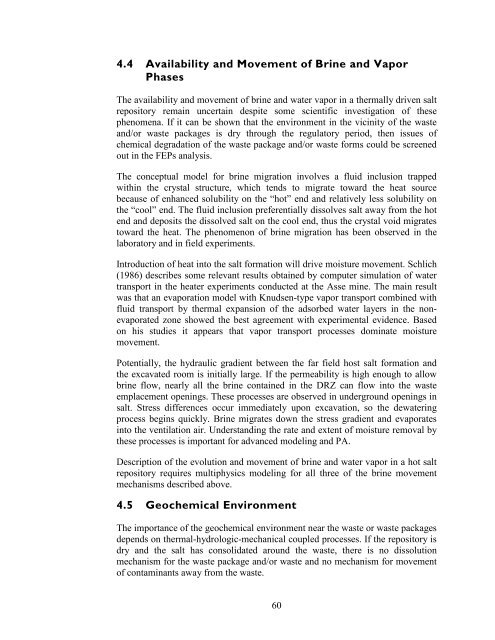Salt Disposal of Heat-Generating Nuclear Waste
Salt Disposal of Heat-Generating Nuclear Waste
Salt Disposal of Heat-Generating Nuclear Waste
Create successful ePaper yourself
Turn your PDF publications into a flip-book with our unique Google optimized e-Paper software.
4.4 Availability and Movement <strong>of</strong> Brine and Vapor<br />
Phases<br />
The availability and movement <strong>of</strong> brine and water vapor in a thermally driven salt<br />
repository remain uncertain despite some scientific investigation <strong>of</strong> these<br />
phenomena. If it can be shown that the environment in the vicinity <strong>of</strong> the waste<br />
and/or waste packages is dry through the regulatory period, then issues <strong>of</strong><br />
chemical degradation <strong>of</strong> the waste package and/or waste forms could be screened<br />
out in the FEPs analysis.<br />
The conceptual model for brine migration involves a fluid inclusion trapped<br />
within the crystal structure, which tends to migrate toward the heat source<br />
because <strong>of</strong> enhanced solubility on the “hot” end and relatively less solubility on<br />
the “cool” end. The fluid inclusion preferentially dissolves salt away from the hot<br />
end and deposits the dissolved salt on the cool end, thus the crystal void migrates<br />
toward the heat. The phenomenon <strong>of</strong> brine migration has been observed in the<br />
laboratory and in field experiments.<br />
Introduction <strong>of</strong> heat into the salt formation will drive moisture movement. Schlich<br />
(1986) describes some relevant results obtained by computer simulation <strong>of</strong> water<br />
transport in the heater experiments conducted at the Asse mine. The main result<br />
was that an evaporation model with Knudsen-type vapor transport combined with<br />
fluid transport by thermal expansion <strong>of</strong> the adsorbed water layers in the nonevaporated<br />
zone showed the best agreement with experimental evidence. Based<br />
on his studies it appears that vapor transport processes dominate moisture<br />
movement.<br />
Potentially, the hydraulic gradient between the far field host salt formation and<br />
the excavated room is initially large. If the permeability is high enough to allow<br />
brine flow, nearly all the brine contained in the DRZ can flow into the waste<br />
emplacement openings. These processes are observed in underground openings in<br />
salt. Stress differences occur immediately upon excavation, so the dewatering<br />
process begins quickly. Brine migrates down the stress gradient and evaporates<br />
into the ventilation air. Understanding the rate and extent <strong>of</strong> moisture removal by<br />
these processes is important for advanced modeling and PA.<br />
Description <strong>of</strong> the evolution and movement <strong>of</strong> brine and water vapor in a hot salt<br />
repository requires multiphysics modeling for all three <strong>of</strong> the brine movement<br />
mechanisms described above.<br />
4.5 Geochemical Environment<br />
The importance <strong>of</strong> the geochemical environment near the waste or waste packages<br />
depends on thermal-hydrologic-mechanical coupled processes. If the repository is<br />
dry and the salt has consolidated around the waste, there is no dissolution<br />
mechanism for the waste package and/or waste and no mechanism for movement<br />
<strong>of</strong> contaminants away from the waste.<br />
60
















